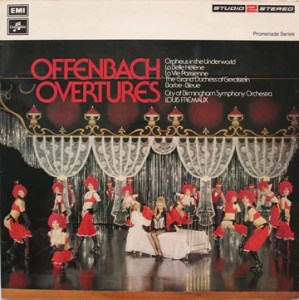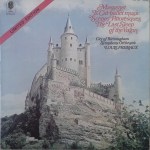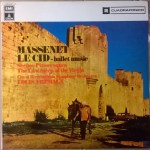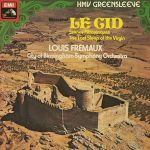 More of the music of Jules Massenet (1842—1912)
More of the music of Jules Massenet (1842—1912)
Reviews and Commentaries for the Music of Jules Massenet (1842—1912)
About ten years ago we reviewed a copy of the album that had a sub-optimal side two, a side two that suffered from screechy string tone.
Since that time we’ve made a number of improvements to our cleaning regimen and playback system, and the result has been that our last couple of shootouts went off without a hitch, showing us string tone that was virtually free of screechiness. (The Greensleeves reissues never had much of a screechy strings problem as they tended to be mastered on the smooth side. They are more forgiving of second-rate playback in that respect, but they can also never win shootouts with that overly smooth sound.) [1]
Problem solved! The records were fine, we just couldn’t play them back then as well as we can now.
In 2012, ten years ago, I had been selling records to audiophiles professionally for 25 years. I had owned a State of the Art system for 37 years.
But I knew I still had plenty to learn, and I kept at it.
After a decade’s worth of tweaking and tuning, the strings of this recording started to sound the way Stuart Eltham and his fellow engineers undoubtedly wanted them to.
This is how you chart your audio progress, by challenging yourself with difficult to reproduce recordings and building on the improvements you continue to make as the years and decades go by.
If you’re in the market for records that can show you that there is still plenty of work left to be done in this crazy audio hobby we’ve all chosen, we have scores of them on the Better Records site.
If we can get them to sound better, so can you.
[1] Our latest preoccupation here on the blog is to point out as often as we can that the Modern Heavy Vinyl remastered pressing is too often just too damn smooth.
The remastered box sets of The Beatles (see: Pepper, Sgt.., etc.) are the poster boys for making records sound more “analog” by boosting the bass and smoothing the treble, like your old ’70s system used to do. (Those of you who were in the hobby back then know exactly the sound I am talking about. For those who would like to know more, we wrote this overview.)
The Beatles records that we sell as Hot Stampers have nothing in common with that absurdly artificial approach. Mid-Fi systems may benefit from more bass and less top end, but Hi-Fi systems worthy of the name will not, hence our distaste for this kind of EQ overreach. More examples of overly smooth modern records can be found here, with more to be added as time permits.
Our Review from 2012
This is a record that clearly belongs on a Super Disc list. If Harry hadn’t already put it there we certainly would have.
We would love to compile a Super Disc list of our own, but unless you have just the right copy of whatever title you find on the list, you may not have anything like Super Disc sound quality, so why a list at all? It creates more problems for audiophiles than it solves. [We have since changed our minds about Super Disc lists.]
Both sides of this TAS List disc contain audiophile Must Own Demonstration pieces, full of Tubey Magic, powerful dynamics, real depth, lifelike ambience, and uncannily accurate instrumental timbres, especially from the woodwinds. Add explosive dynamics and deep bass and you have yourself a genuine audiophile recording.
The sound is so rich you will not believe you are listening to an EMI. If more EMI records sounded like this we would be putting them on the site left and right. Unfortunately, in our experience the majority are thin, shrill and vague. Not so here.
Side One – Le Cid
A+++, so much bigger and livelier than the other copies we played. Huge size and scope, with an extended top, good texture to the strings, and lower strings that are rich and rosiny in the best tradition of vintage Deccas and RCAs.
As it stands it is clearly a Demo Disc of real power. It’s smooth and natural, which means you can really turn it up if you want that front row center seat.
Side Two – Scenes Pittoresques / The Last Sleep of the Virgin
A+ to A++, good, just clearly not as good as this amazing side one. It’s big, rich and spacious — 3-D in fact — but the string tone is not as warm and textured as it should be.
Which means it has some of that typically screechy EMI String Sound one often hears on their recordings.
(more…)











 More of the Music of Camille Saint-Saens (1835-1921)
More of the Music of Camille Saint-Saens (1835-1921)